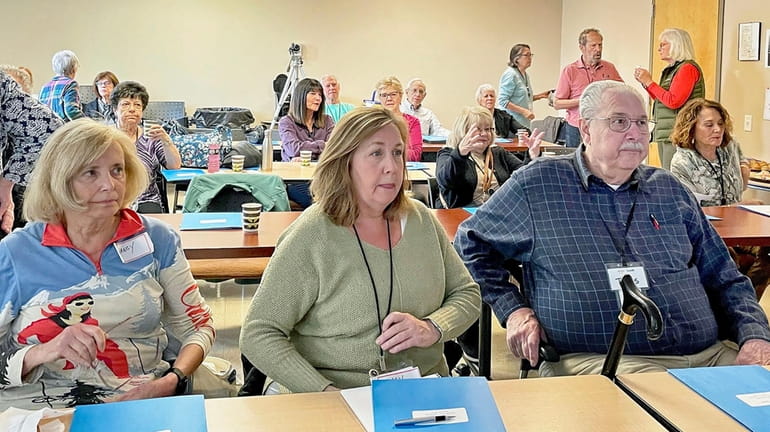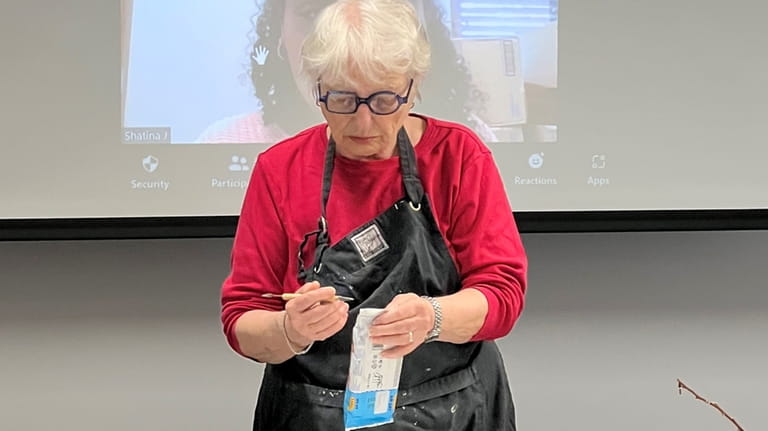Chief concerns for older Long Islanders: Staying in their homes and being able to afford it

SeniorNet volunteers attend a training session last week at the Family Service League in Bay Shore. The SeniorNet program teaches seniors to use and get the most out of technology, according to the League. Credit: Family Service League
As Long Island's senior population continues to rise, the top concerns of older residents are affordable housing and being able to stay in their own homes with sufficient support when necessary, several organizations that work with seniors say.
Data from the 2020 census released last week showed the number of those age 65 and over on Long Island increased 3.8 percentage points between 2010 and 2020, from 14.3% to 18.1%. And the Island's median age rose almost two years during that period: from 40.4 years old to 42.
The increase in older population, while no surprise, suggests more needs to be done to adequately provide myriad support services to seniors, officials said. They cited measures underway to help, but said health and housing challenges are increasing as people grow older.
For example, it is "extraordinarily costly" for people who need to go into assisted living or nursing home care, said Theresa Regnante, president and chief executive of the United Way of Long Island.
WHAT TO KNOW
- The top concerns of older residents are affordable housing and being able to stay in their own homes with sufficient support when needed, organizations that work with seniors say.
- Officials cited measures underway to help, but said health and housing challenges are growing as people grow older.
- Long Island's senior population continues to rise: Recent census data showed the number of those age 65 and over on Long Island increased 3.8 percentage points between 2010 and 2020.
"People are losing their entire assets of their homes," Regnante said. As a result, she said, the United Way is focusing on preventive measures.
"Five years ago we started an age-in-place strategy in the homes" for people age 62 and above. "We take on 75 projects a year," Regnante said.
The agency adapts clients' homes, such as installing handrails, and takes on other renovations to make it easier for the homeowner to get in and out of their home.
"Even something as small as electrical outlets, raising them from 6 inches off the ground up to 3 feet high. We try to go in and do modifications to help the homeowner age in place," Regnante said. She said most of the projects cost between $4,000 and $5,000.
Challenges of staying home
Regnante said her agency also has identified people it can't help; those "who are underwater [on their mortgages], facing foreclosure. There are very little solutions for people to age in place on Long Island."
An AARP New York survey last year found that 84% of people age 65 and up said staying in their own home was "extremely or very important" to them, said Beth Finkel, state director of AARP New York, a division of the national organization that advocates for people age 50 and over.
When asked how much increasing property taxes would affect their ability to remain in their homes as they age, 72.8% of those 65 and over responded it would affect their ability "a lot," Finkel said. Among Long Island respondents, it was a little higher, at 73.9%.
The survey also asked whether having high quality long-term care in their community was important to them. Finkel said 75.8% of the 65-and-over respondents said it was extremely or very important.
Finkel added, "There's a terrible problem all across New York State getting home care workforce stability because people don’t want to work at low-paying jobs when they could possibly get more money flipping burgers. … Our contention is they're not being treated professionally or paid appropriately."
A home-share 'win-win'
Robyn Berger-Gaston, division director at the Family Service League who oversees programs for seniors, said the nonprofit agency, focused primarily in Suffolk County, started a home-share program to address affordability concerns.
"Right now we have a lot of people looking for affordable housing. We’re also aware of seniors who are isolated in their homes who want some companionship and are struggling financially," Berger-Gaston said.
The HomeShare program matches homeowners, typically seniors, who might have a room to rent and may need help around the house, with someone that Berger-Gaston said "needs an affordable place to live. They could shovel snow, rake leaves. The homeowner benefits and home-seeker benefits. It’s win-win."
She said there has been an increase in requests for HomeShare services, for caregiver support, and for a program, in Greenport, called a naturally occurring retirement community, or NORC.

NORC member Marsha Lipsitz shows others how to create art using clay during one of the Family Service League's programs in Greenport recently. Credit: Family Service League
"It’s a geographic area with a high concentration of people over 60," Berger-Gaston said of the North Fork community. "We have funding from New York State to provide case management, health management." she added. "Our program is only for the ZIP codes of Greenport. We’re finding people in other towns are hearing about it."
She said she was aware of other nonprofits that service NORCs in other communities on Long Island.
One academic pointed to housing needs that converge for younger Long Islanders and seniors.
"As those Baby Boomers become older, they’re going to struggle more with mobility," said Christopher Niedt, academic director of Hofstra University's National Center for Suburban Studies. "Some will be able to maintain their independence longer if they had access to elevator apartments, multifamily housing. ... If they had more access to affordable senior housing and so on.
"In some ways, those two issues: the aging of the Baby Boomers and the need to appeal to younger adults converge in the conversation about housing types," he said.
The growth of the elderly population was "confirmation of trends that have been expected ever since the birthrate started falling after the Great Recession," which occurred from December 2007 to June 2009, Niedt said.
With Arielle Martinez
Gilgo Manorville search ... Southold hotel pause ... Home sales ... What's up on Long Island
Gilgo Manorville search ... Southold hotel pause ... Home sales ... What's up on Long Island

